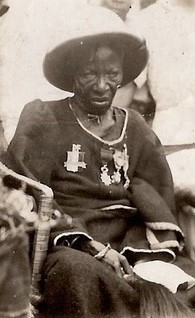| Ngalifourou | |
|---|---|
| Queen | |
 | |
| Queen consort | c.1880 - 1892 |
| Queen Mother | 1892 - 1956 |
| Born | 1864 Ngabé |
| Died | 8 June 1956 Ngabé |
| House | Mbe |
| Religion | Teke spiritualism |
Ngalifourou (1864 – 8 June 1956) was a queen of the Mbé region in what is today the Republic of Congo (Congo-Brazzaville). As a ruler she was close to French colonial authorities and was the first ruler in her region to sign a treaty with them.
Biography
Ngalifourou was born in 1864 in Ngabé on the Congo River. A member of the Téké people, who are a Bantu community living between the present-day Democratic Republic of the Congo and the Republic of the Congo, Ngalifourou was married at the age of 15 to King Iloo I (also known as Iloo Makoko), who was much older than her. She was his second wife. Oral traditions suggest they married in 1880.
After their marriage, Ngalifourou upheld the king's authority and gained respect for her intelligence, including from Pierre Savorgnan de Brazza, who was a French colonial army officer who collaborated with her husband. De Brazza presented Ngalifourou with a sabre as a gesture of admiration. In 1944, de Brazza's daughter, Marthe de Brazza, visited Ngalifourou, who showed her the sword and discussed her father with de Brazza. This 'collaboration' between de Brazza, Iloo Makoko and, indeed, Ngalifouroou, was in fact a treaty signed by Iloo Makoko in 1880, which ceded Teke territory to France, thus establishing French Congo.
At the death of King Iloo I in 1892, Ngalifourou ascended to the throne as Man Ounko (Queen Mother) of the Mbé Kingdom. Tradition meant that Ngalifourou needed to marry again, which she did, but she and the new king lived apart, something that was an accepted practice in Téké customs; neither did they have children. She did however, return to live in her birthplace in Ngabé.
Spiritual life
Ngalifourou was a spiritual leader as well. She did this through close association with Nkwe Mbali, spirituality associated with the king. Due to her supposed spiritual power, many people made pilgrimages to visit her at Ngabé where she would receive visitors on her likouba royal stool. As a result Ngalifourou was targeted by Catholic and Protestant missionaries who wanted her to adopt one of their faiths, knowing that if she did so it would influence others; however she resisted and continued Téké spiritual practices.
French colonial rule
However, Ngalifourou did not retire from public life, but became a prominent figure known to the French colonial administration. She was seen as an example of a traditional ruler, who accepted colonial rule. She signed the first treaty between a traditional ruler and the French. She met General de Gaulle on several occasions, notably in March 1944, when she was presented with the Légion d'honneur medal. To cement her relationship with the French, she encouraged Teké soldiers to join the French military in both the First World War and the Second World War. Such was her relationship with the colonial authorities that some Teké referred to her as "Ngalifourou, the woman of the whites". In the late 1940s and early 1950s, her influence waned as political parties wanted independence from the French grew in popularity.
Ngalifourou died on 8 June 1956. Her funeral became a tool for the French authorities to try and prop up their power and they arranged a huge funeral for the former queen, which was attended not just by local colonial dignitaries, but by representatives from other French colonies, the Vatican and the Belgian Congo. Journalists had been encouraged to stay in Ngabé to report on the queen's final days as well as her funeral.
Awards and honours
- Légion d'honneur (1944).
- Order of the Star of the Comoros Island of Anjouan.
- Medal of Overseas Service of Benin.
Legacy
The role of Queen Mother is still respected in Teké society and the person in that role bears the name Ngalifourou out of respect for their predecessor. She is also listed by UNESCO as one of the most important women in African History.
Ngalifourou features in the poem Le pardon de l'adieu by Tchicaya U Tam'Si.
Bibliography
- La reine Ngalifourou souveraine des Téké - Eugénie Mouayani Opou (2006).
References
- ^ "Ngalifourou, dernière souveraine d'Afrique noire". L'Histoire par les femmes (in French). 2016-02-29. Retrieved 2021-01-15.
- ^ jeremy, rich (2012), Akyeampong, Emmanuel K; Gates, Henry Louis (eds.), "Ngalifourou", Dictionary of African Biography, Oxford University Press, doi:10.1093/acref/9780195382075.001.0001, ISBN 978-0-19-538207-5, retrieved 2021-01-15
- ^ "UNESCO Women in Africa History | Women". en.unesco.org. Retrieved 2021-01-16.
- ^ Bernault, Florence (1996-01-01). Démocraties ambiguës en Afrique centrale: Congo-Brazzaville, Gabon, 1940-1965 (in French). KARTHALA Editions. ISBN 978-2-86537-636-0.
- "The man who would be Congo's king". 2003-02-12. Retrieved 2021-01-16.
- dir.), Robert Edmond ZIAVOULA (ss (2006-11-01). Brazzaville, une ville à reconstruire (in French). KARTHALA Editions. ISBN 978-2-8111-4128-8.
- Stroeken, Koen (2018-09-07). Medicinal Rule: A Historical Anthropology of Kingship in East and Central Africa. Berghahn Books. ISBN 978-1-78533-985-1.
- Tam'Si, Tchicaya U (1960). "Le pardon de l'adieu". Présence Africaine (30): 74–76. ISSN 0032-7638. JSTOR 24345380.
- Opou, Eugénie Mouayani (2006-09-15). La reine Ngalifourou souveraine des Téké (in French). Editions L'Harmattan. ISBN 978-2-296-15515-2.